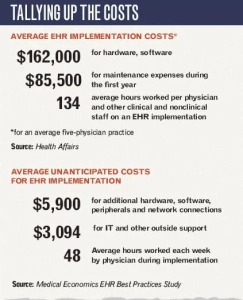Hidden costs in EMR software can come as an unpleasant surprise to most buyers. When evaluating options for Electronic Medical Records (EMR) software, it’s important to be aware of these. Here’s a list of some common hidden costs associated with EMR software:
Implementation and Training Costs
One of the first things that happens when you buy a new EMR software is training and implementation. This includes setting up the software, data migration, and training your staff to use it effectively. All of these are additional expenses. Training can be an ongoing cost if you have staff turnover or need additional training sessions.
Customization Costs in EMR Software
If you need to tailor the EMR software to your specific workflow or requirements, customization costs can add up. Custom development, integrations with other systems, or additional features may come with extra fees.
Support and Maintenance Fees
Most EMR software providers charge ongoing fees for software updates, technical support, and maintenance. These costs can vary depending on the level of support you need.
Hardware Costs
You may need to invest in new hardware or upgrade your existing infrastructure to meet the software’s system requirements. This includes servers, workstations, and networking equipment.
Data Storage Costs in EMR Software
As your patient data accumulates, you may need to expand your data storage capacity, which can result in additional expenses for cloud storage or server upgrades.
Backup and Disaster Recovery
Ensuring the security and availability of patient data requires robust backup and disaster recovery solutions. These services often come with their own costs.
Compliance and Security Costs in EMR Software
Meeting regulatory requirements such as HIPAA (Health Insurance Portability and Accountability Act) can entail expenses for security audits, encryption, and compliance monitoring.
Software Upgrades
Some EMR providers charge for major software upgrades or new versions. It’s essential to factor in the cost of staying up-to-date with the latest software releases.
User License Fees
Many EMR systems charge per user, so as your practice grows, you’ll incur additional costs for adding new users.
Third-Party Integration Costs in EMR Software
If you need to integrate your EMR software with other healthcare systems or applications, there may be fees associated with third-party software or development.
Subscription Renewal Increases
Be aware that some EMR software providers may increase their subscription fees over time, potentially impacting your long-term budget.
Data Migration Costs in EMR Software
If you switch to a new EMR system, you may incur costs for migrating your existing patient data from the old system to the new one.
Consulting and Advisory Services
You might need to hire consultants or advisors to help with EMR selection, implementation, or optimization, which can add to your overall costs.
To avoid unpleasant surprises, it’s crucial to conduct a thorough cost analysis and seek transparency from EMR vendors regarding all potential costs associated with their software. Additionally, consider the long-term benefits and efficiency gains that the EMR system can provide.









